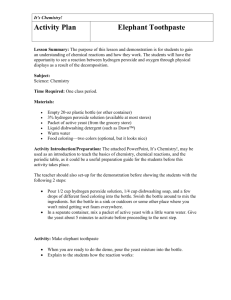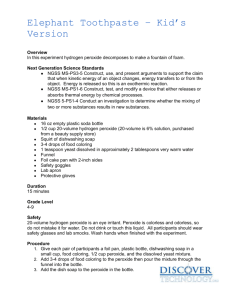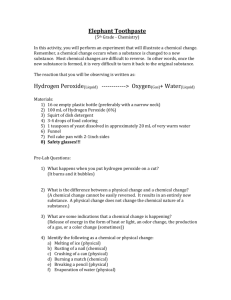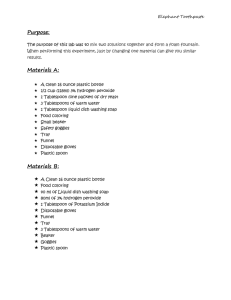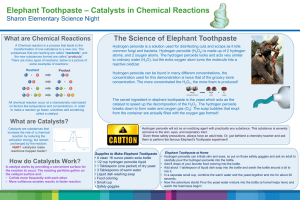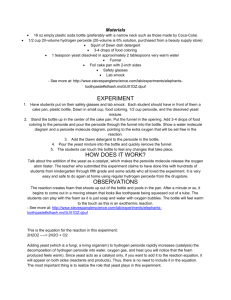Elephant Toothpaste Notebook
advertisement
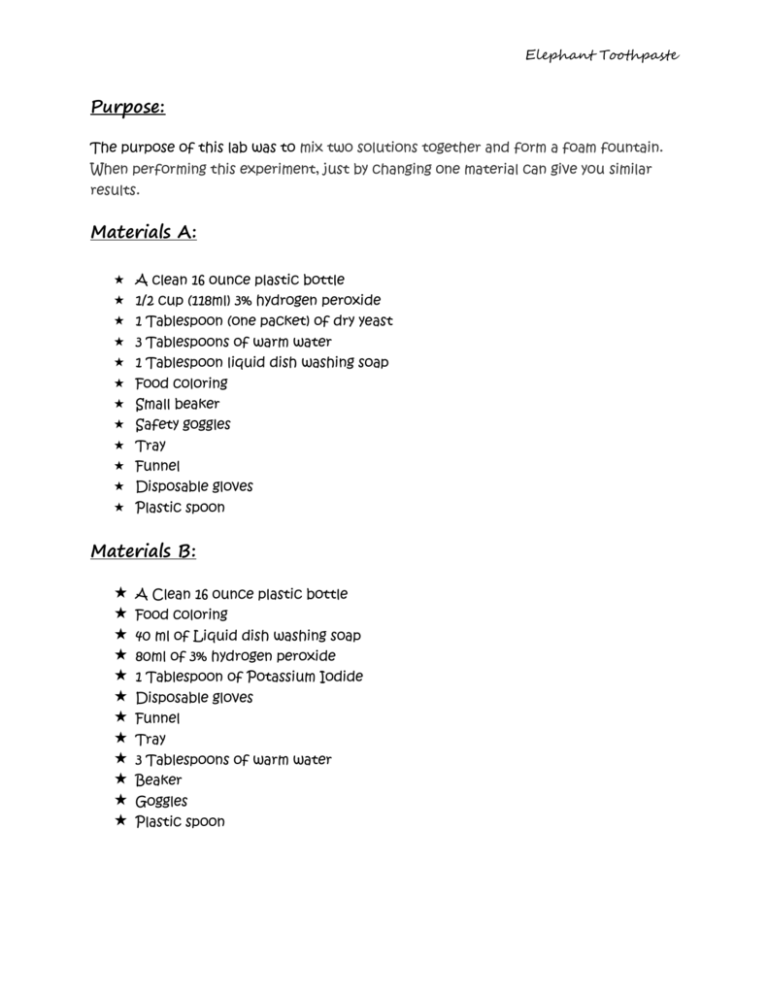
Elephant Toothpaste Purpose: The purpose of this lab was to mix two solutions together and form a foam fountain. When performing this experiment, just by changing one material can give you similar results. Materials A: A clean 16 ounce plastic bottle 1/2 cup (118ml) 3% hydrogen peroxide 1 Tablespoon (one packet) of dry yeast 3 Tablespoons of warm water 1 Tablespoon liquid dish washing soap Food coloring Small beaker Safety goggles Tray Funnel Disposable gloves Plastic spoon Materials B: A Clean 16 ounce plastic bottle Food coloring 40 ml of Liquid dish washing soap 80ml of 3% hydrogen peroxide 1 Tablespoon of Potassium Iodide Disposable gloves Funnel Tray 3 Tablespoons of warm water Beaker Goggles Plastic spoon Elephant Toothpaste Procedure A: 1. Put on safety goggles and gloves. 2. Place plastic bottle onto tray. 3. Carefully pour ½ a cup of the 3% hydrogen peroxide into the 16 ounce plastic bottle. 4. Add 8 drops of food coloring into the bottle. 5. Add 1 tablespoon of dish soap into the bottle. 6. Swish the bottle around to mix it. 7. Put aside. 8. Add 3 Tablespoons of water to an empty beaker. 9. Add 1 Tablespoon of yeast to the water. 10. Mix with a plastic spoon for about 30 seconds. 11. Pour the mixture of water and yeast into the bottle using a funnel. 12. Observe the reaction. 13. Disposal: Leave the gloves on while cleaning up. Rinse the foam in the bottle down the sink. Procedure B: 1. Put on safety goggles and disposable gloves. 2. Place the plastic bottle onto the tray. 3. Add 2 tablespoons of potassium iodide into the 16 ounce plastic bottle. 4. Then add 3 tablespoons of water to the bottle. 5. Close the bottle and shake until all the potassium iodide is dissolved. 6. Set aside. 7. Pour 80 ml of 3% hydrogen peroxide into a beaker. 8. Add 40 ml of dish soap to the hydrogen peroxide. 9. Swirl to mix. 10. Add 8 drops of food coloring to the beaker. 11. Using the funnel add the hydrogen peroxide to the plastic bottle. 12. Observe the reaction. 13. Disposal: Leave the gloves on while cleaning up. Rinse the foam in the bottle down the sink. Elephant Toothpaste Date and Observations: Experiment A: Experiment B: Hydrogen peroxide molecules are very unstable and naturally decompose into water and oxygen gas. The chemical equation for this decomposition is: The overall equation for this reaction is 2 H2O2(aq) --> 2 H2O(l) + O2(g) hydrogen peroxide 2H2O2 → water + oxygen → 2H2O + O2 The yeast acted as a catalyst to remove the oxygen from the hydrogen peroxide. Since it did this very fast, it created lots and lots of bubbles. The decomposition of the hydrogen peroxide into water and oxygen is catalyzed by the iodide ion. H2O2(aq) + OI-(aq) --> I-(aq) + H2O(l) + O2(g) This had a soapy scent of apples due to the dishwashing soap The dishwashing detergent captures the oxygen as bubbles. Each tiny foam bubble is filled with oxygen. Food coloring changed the foam to a blue-green color. Food coloring changed the foam to a red- Had a fresh baked bread scent. yellow color. The experiment created a reaction called The experiment created an an exothermic reaction. exothermic reaction as well. -that means it not only created foam, it also created heat! -the bottle was warm as well. Elephant Toothpaste Analysis Questions: 1. What does a catalyst do in a chemical reaction? A. Catalysts help a reaction happen faster but do not change themselves during the reaction. 2. What clues did you have that a chemical reaction occurred in this activity? A. The bubbling and the heating of the bottle are examples of a chemical reaction. 3. What evidence do you have that hydrogen peroxide decomposed faster when you added yeast? A. Bubbles of oxygen gas were produced after the yeast was added. 4. Why is warm water best to use in this experiment? A. Warm water is best for yeast because yeast is a living organism that likes to live in similar temperatures to humans. Put yeast in hot water and it dies, put it in cold water and it will not do its job properly (will be too cold to reproduce fast). 5. What is actually all happening? A. Hydrogen peroxide is H2O2, which means it is water (H2O) with one extra oxygen. When yeast is added, it acts as a catalyst to split the hydrogen peroxide into water and oxygen. Bubbles of oxygen are trapped in the soap, which transforms into the foam fountain. The product formed is just soap, water, and oxygen. Elephant Toothpaste Conclusion: This experiment used hydrogen peroxide and potassium iodide (yeast was used in experiment A), mixed with dish soap and water. If you add all these together, the hydrogen peroxide's decomposition is sped up by the catalyst, potassium iodide (yeast in experiment A). Oxygen is given off and forms foam with the dish soap. The foam pushes up in the bottle and comes out the top looking like toothpaste. An exothermic process releases heat, and causes the temperature of the immediate surroundings to rise. The process of the bottle warming up is one example of an exothermic process. The formation of bubbles is also an example of this. It is an exothermic reaction because the fizzing is carbon dioxide which is being released as heat. A catalyst is a substance that increases the rate of a chemical reaction without itself undergoing any permanent chemical change. Both experiments had many similarities rather than differences. Some similarities were they both started off producing foam right away once the hydrogen peroxide was added. The soap added was settled at the bottom. The bottle was also warm for both experiments. The smells were different, the yeast one smelled like fresh baked bread and the Potassium Iodide one smelled just like the dish soap added which was the smell of apples. The Potassium Iodide experiment looked a bit watery compared to the yeast experiment. Maybe because 40ml of dish soap was added compared to the one tablespoon added with the yeast. The main goal was to produce foam and they both did as so.
